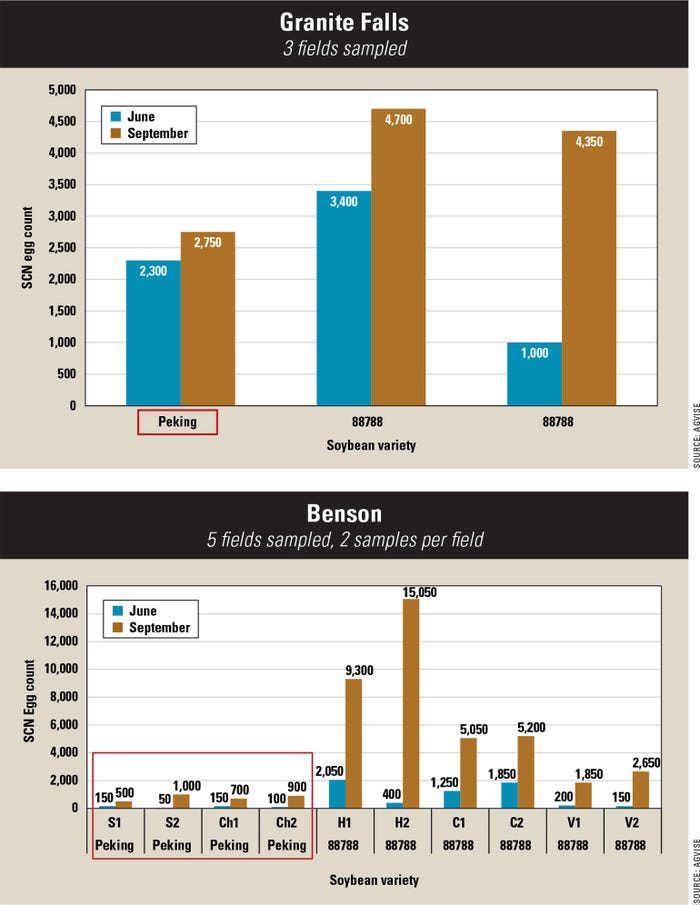February 17, 2021

Last growing season, AgVise Laboratories conducted an interesting soybean cyst nematode soil-testing project in which I was able to submit some samples. I’ve got the sample results back and I think they tell an interesting story.
I’ll provide my interpretation here. As of late January, I had not heard how AgVise will interpret the results. I look forward to hearing its opinion as well.

ADDRESS SCN: Crop adviser Dorian Gatchell, Granite Falls, Minn., agrees that SCN management needs to be part of the crop management discussion. (Paula Mohr)

The general idea of the AgVise project was to see if there was a way for soybean growers to determine if soybean cyst nematode populations in their fields have overcome the two major forms of genetic resistance we have available —— resistance known as PI 88788 and Peking. Currently, the only way to find out if your SCN populations have developed resistance to these plant introductions is to conduct a test known as the HG Type test, which takes a long time and is quite expensive.
Simply, the HG Type test is a method where SCN from your field is grown on soybeans, and the amount of SCN reproduction is measured. If little reproduction is recorded from a soybean with genetic SCN resistance, then the plant’s resistance is effective. If lots of reproduction is measured, then the plant’s genetic resistance is considered ineffective. Remember that the HG Type test measures your SCN population. The same plant resistance may be quite effective in your field, but quite ineffective in a field down the road.
AgVise's project emulated the HG Type test by taking a SCN sample in the spring and again in the fall at the same location, and then compared the two SCN levels. If the levels are similar or lower, one could reasonably assume that the soybean genetic resistance is effective. If they are higher, then one could assume they are ineffective. Keep in mind that this type of test does not replace the HG Type test. A number of other factors can influence the final numbers you get. However, it offers a good view of the trajectory your SCN populations are taking with the type of soybean you are growing.
Project results
So, what did the results from the sampling project show? I thought they were quite interesting and share results on two locations (see charts). Samples from three Granite Falls, Minn., fields I submitted were taken in known SCN hotspots. Standard SCN management recommendations say that soybeans, if planted in fields at this SCN level, would experience a reduced yield. In fact, they did.
 GROWING RESISTANCE: Samples taken in September versus June in 2020 near Granite Falls and Benson, Minn., show that SCN-resistance varieties had higher SCN eggs counts. (Courtesy of Dorian Gatchell)
GROWING RESISTANCE: Samples taken in September versus June in 2020 near Granite Falls and Benson, Minn., show that SCN-resistance varieties had higher SCN eggs counts. (Courtesy of Dorian Gatchell)

Another important point is that the Peking variety has been known to show better resistance to SCN than 88788. And in this case, that was seen as well. Also notice that two fields, both with 88788, have radically different levels of SCN increase, indicating that one SCN population has most likely overwhelmed the plant’s genetic resistance.
The five fields sampled in Benson, Minn., show a number of samples of both Peking and 88788 resistance. Notice the dramatic difference in SCN reproduction between the two. Again, you can see that 88788 has a wider range of reproduction, indicating to me that possibly the SCN populations tested have deemed 88788 noneffectual. But what is more disturbing to me is the range of reproduction on the Peking resistance —— up to 20 times in at least one instance.
I raise this issue because every year, some growers talk about the increased management they are going to apply to soybeans to boost yield, but they don't talk about including SCN management as part of their efforts.
Not addressing SCN will negate all other management they apply.
When growers ask me to look at specific fields or portions of fields to determine why those fields will not support good soybean yields, my first focus is on SCN.
To sum up, if you are dealing with weed herbicide resistance, insecticide resistance and fungicide resistance, you are probably dealing with SCN resistance in the plant’s genetic SCN-resistant varieties. You just don't know about the last one yet.
Gatchell is a certified crop adviser and owner of Minnesota Agricultural Services, Granite Falls.
Source: Minnesota Agricultural Services, which is solely responsible for the information provided and is wholly owned by the source. Informa Business Media and all of its subsidiaries are not responsible for any of the content contained in this information asset.
You May Also Like




